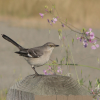oryx
A genus of large antelope, the oryx is native to the various arid parts of Africa. This herbivore is well-adapted to surviving in dry conditions and can live up to ten months without drinking water by reducing perspiration and minimizing urine production. It is recognized by its beautiful colors and long, almost straight horns. Once widespread across Africa, the oryx is now endangered due to extensive hunting and climate change, with two of its four species coming close to extinction.










